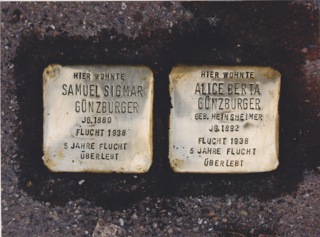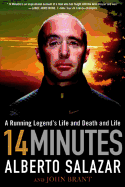 As a New York Times investigative reporter, Leslie Maitland, whose mother, Janine, fled Germany with her family in 1942, visited Germany with her parents in 1989 as part of a "reconciliation" program to welcome former citizens, and reported on the emotional visit in a lengthy Times article.
As a New York Times investigative reporter, Leslie Maitland, whose mother, Janine, fled Germany with her family in 1942, visited Germany with her parents in 1989 as part of a "reconciliation" program to welcome former citizens, and reported on the emotional visit in a lengthy Times article.
Crossing the Borders of Time: A True Story of War, Exile, and Love Reclaimed (Other Press), grew out of that article, and traces her mother's life from her birth in Alsace, to her escape from Nazi-occupied France and resettlement in New York, to the present, including her hope to eventually reunite with the man who waved goodbye as the refugee ship sailed. Her mother spent a lifetime mourning him, the love of her life.
After the story ran, Maitland was surprised that "stacks of mail" arrived on her desk from people sharing similar stories, even from some who remembered her mother before her escape at age 19. This outpouring of interest and a second trip to Germany in 1990 inspired her to begin the book and eventually search for Roland, the young man Janine left on the dock in Marseille. Maitland explained, "The love story is the ribbon of narrative that goes through the book, the candy that lures the reader along, because the romance is very much situated in the context of history."
 "As the daughter of Jewish survivors," she felt her mission was to tell the story on behalf of the millions who died who cannot, and "the reality of how it affected one family will make it more real and lasting and people will not forget," Maitland hopes.
"As the daughter of Jewish survivors," she felt her mission was to tell the story on behalf of the millions who died who cannot, and "the reality of how it affected one family will make it more real and lasting and people will not forget," Maitland hopes.
Noting that even well-educated people usually do not know the whole story of the war years, she hoped to provide a "mirror of the period," and is confident that her facts are true. She loves research and said she discovered facts she "never could have invented." She had to bend her Times reporting standards a bit, though, coming to accept second-person quotes: "If Mom said so-and-so said this, I had to believe it."
Maitland's family's memories were just the start of her extensive research. She returned to Europe and also visited Cuba, the site of a little-known refugee camp where the family was held en route to New York. "This is the first complete reporting of the Tiscornia camp, on the northeast side of Havana Harbor," where hundreds of refugees from Hitler's Europe awaited the papers that would grant them entry to America, most for months, in prison-like conditions, Maitland said.
She read bound newspapers in French that revealed the way Europe was changing, and found "tiny articles about camps in Germany, and stories about French women sewing valuables in the lining of their clothes" as the Nazis grew closer. Her family and relatives "had saved all the strings," she marveled. Her grandfather kept the family's visas, transit papers and letters. Her mother still had the 12-page farewell letter from Roland. "Having all that in original words helped me so much to feel comfortable that I was getting everything right."
Janine's devotion to Roland never flags, even when they fail to find each other after the war, and Janine marries and has a family. Maitland's determination to provide closure for her mother by finding what became of Roland provides a sweet ending to this meticulously researched history of horrific tragedy.
"In a way the book is also a feminist story, of a life-affirming time for my mother who later in her life decided to do something for herself, having always lived for her parents, then her husband and children," Maitland said.
Her trips to the towns where her grandparents and mother lived revealed larger truths as well. Visiting Freiburg, her grandfather Gunzburger's birthplace, as part of an official program welcoming survivors, Maitland met with high school teachers and students. "Their families didn't want to talk about the war, and the younger generation is eager to create friendships with Jewish families."
"The problem is we don't have any Jews so we have to invite them back," one man explained. He lived in the Gunzburgers' former home, became friends with the Maitlands, and later joined their seder in New Jersey.
 One way Germans are memorializing victims is by installing metal "stumbling stones"--Stolpersteine--engraved with the names and birth and death (or escape) dates of Holocaust victims and placed in front of their residences. Maitland heard about the project and contacted the artist to arrange to have two Stolpersteine embedded in the sidewalk in front of her grandparents' former home in Freiburg.
One way Germans are memorializing victims is by installing metal "stumbling stones"--Stolpersteine--engraved with the names and birth and death (or escape) dates of Holocaust victims and placed in front of their residences. Maitland heard about the project and contacted the artist to arrange to have two Stolpersteine embedded in the sidewalk in front of her grandparents' former home in Freiburg.
A Frenchman from Lyon visiting Freiburg noticed the stones with the Gunzburger name, which was the same as his great-grandfather's. He contacted the Stolpersteine project to learn who had provided the information for the stones. "The Stolpersteine folks gave him my e-mail address and he contacted me to say that we were related," Maitland recalls. "Our great-grandfathers were brothers! He organized a family reunion in Paris, and we became friends. So the Stolpersteine served not just to mark the spot where my grandparents had lived and from which they had fled, but brought dispersed relations together again!" --Cheryl Krocker McKeon, bookseller
Leslie Maitland: Exploring Family History




 As a New York Times investigative reporter, Leslie Maitland, whose mother, Janine, fled Germany with her family in 1942, visited Germany with her parents in 1989 as part of a "reconciliation" program to welcome former citizens, and
As a New York Times investigative reporter, Leslie Maitland, whose mother, Janine, fled Germany with her family in 1942, visited Germany with her parents in 1989 as part of a "reconciliation" program to welcome former citizens, and  "As the daughter of Jewish survivors," she felt her mission was to tell the story on behalf of the millions who died who cannot, and "the reality of how it affected one family will make it more real and lasting and people will not forget," Maitland hopes.
"As the daughter of Jewish survivors," she felt her mission was to tell the story on behalf of the millions who died who cannot, and "the reality of how it affected one family will make it more real and lasting and people will not forget," Maitland hopes. One way Germans are memorializing victims is by installing metal "stumbling stones"--Stolpersteine--engraved with the names and birth and death (or escape) dates of Holocaust victims and placed in front of their residences. Maitland heard about the project and contacted the artist to arrange to have two Stolpersteine embedded in the sidewalk in front of her grandparents' former home in Freiburg.
One way Germans are memorializing victims is by installing metal "stumbling stones"--Stolpersteine--engraved with the names and birth and death (or escape) dates of Holocaust victims and placed in front of their residences. Maitland heard about the project and contacted the artist to arrange to have two Stolpersteine embedded in the sidewalk in front of her grandparents' former home in Freiburg. Paris has long been recognized as a center of literary activity, drawing authors and poets from all over the world. Ernest Hemingway's classic memoir of his time in Paris, A Moveable Feast, brings to life the literary world of 1920s Paris. This was a city full of literary characters we still know and cherish, from James Joyce to F. Scott Fitzgerald to Gertrude Stein, and Hemingway knew them all. His accounts of his earliest years as a writer are at once captivating and inspiring, and it is near impossible not to fall in love with the city we see through his eyes.
Paris has long been recognized as a center of literary activity, drawing authors and poets from all over the world. Ernest Hemingway's classic memoir of his time in Paris, A Moveable Feast, brings to life the literary world of 1920s Paris. This was a city full of literary characters we still know and cherish, from James Joyce to F. Scott Fitzgerald to Gertrude Stein, and Hemingway knew them all. His accounts of his earliest years as a writer are at once captivating and inspiring, and it is near impossible not to fall in love with the city we see through his eyes. Of course, not everyone loves Paris the way Hemingway loved Paris. A Year in the Merde, Stephen Clarke's comic account of his one year in Paris, takes on the less glamorous sides of Parisian life, or at least those that appear less glamorous to a British ex-pat living in the city somewhat against his will. After a few months of work in the famed city of light and long vacations, Clarke finds himself desperate to assimilate, struggling to understand why he is incapable of getting anything done and hard-pressed to explain his love life to anyone--including himself.
Of course, not everyone loves Paris the way Hemingway loved Paris. A Year in the Merde, Stephen Clarke's comic account of his one year in Paris, takes on the less glamorous sides of Parisian life, or at least those that appear less glamorous to a British ex-pat living in the city somewhat against his will. After a few months of work in the famed city of light and long vacations, Clarke finds himself desperate to assimilate, struggling to understand why he is incapable of getting anything done and hard-pressed to explain his love life to anyone--including himself. And then there are those who love Paris and hate it at the same time, who long to be nowhere else, and yet anywhere else. This is the case for Amy Thomas, a sweet freak and longtime Francophile, who eagerly accepts an opportunity to relocate to Paris for work. There, she explores the city through its patisseries and spends her time contemplating where she truly belongs. Thomas's story in
And then there are those who love Paris and hate it at the same time, who long to be nowhere else, and yet anywhere else. This is the case for Amy Thomas, a sweet freak and longtime Francophile, who eagerly accepts an opportunity to relocate to Paris for work. There, she explores the city through its patisseries and spends her time contemplating where she truly belongs. Thomas's story in 













